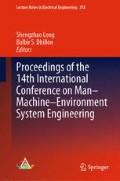Abstract
This paper includes three chapters. Chapter 1 introduces the concept of evidence-based ergonomics (EBE) and the relationship between evidence-based medicine (EBM) and EBE. Chapter 2 shows the framework of EBE model composed of six levels based on four requirements of human factors and ergonomics science (HFES). Chapter 3 collects the application instances of EBE in manned space flight, containing space human factors engineering (SHFE) project plan (JSC 29022 Rev A), Space human factors engineering gap analysis project final report (NASA/TP-2007-213739), Human health and performance risks of space exploration missions (NASA/SP-2009-3405), 2011 Space Human Factors Engineering Standing Review Panel (SRP) Evidence Review Final Report, Evidence Report: Risk of Inadequate Critical Task design (2013).
Funding information: China manned space flight project fund.
Access this chapter
Tax calculation will be finalised at checkout
Purchases are for personal use only
References
Silveira DM (2012) Evidence-based ergonomics. Work 41:487–495
Jensen OC (2009) Ergonomics and epidemiology in evidence based health prevention. In: Bram N Brinkerhoff. Ergonomics. Nova Science Publishers Inc, New York
JSC 29022 Rev A (2001) Space human factors engineering project plan
JSC 29718 (2002) Space human factors engineering project implementation plan
Woolford B, Rathjen T, Whitmore M et al (2003) Space human factors advanced development projects[EB/OL]
NASA/TP-2007-213739 (2007) Space human factors engineering gap analysis project final report
NASA/SP-2009-3405 (2009) Human health and performance risks of space exploration missions
SHFE SRP (2011) Space human Factors engineering standing review panel evidence review final report[EB/OL]
Sándor A, Schuh SV, Gore BF (2013) Evidence report: risk of inadequate critical task design[EB/OL]
Author information
Authors and Affiliations
Corresponding author
Editor information
Editors and Affiliations
Rights and permissions
Copyright information
© 2015 Springer-Verlag Berlin Heidelberg
About this paper
Cite this paper
Liang, H. et al. (2015). Evidence-Based Ergonomics and Application in Manned Space Flight. In: Long, S., Dhillon, B.S. (eds) Proceedings of the 14th International Conference on Man–Machine–Environment System Engineering. MMESE 2014. Lecture Notes in Electrical Engineering, vol 318. Springer, Berlin, Heidelberg. https://doi.org/10.1007/978-3-662-44067-4_50
Download citation
DOI: https://doi.org/10.1007/978-3-662-44067-4_50
Publisher Name: Springer, Berlin, Heidelberg
Print ISBN: 978-3-662-44066-7
Online ISBN: 978-3-662-44067-4
eBook Packages: EngineeringEngineering (R0)

